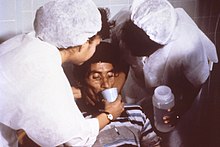
Back معالجة الجفاف عن طريق الفم Arabic মৌখিক পুনরুদন থেরাপি Bengali/Bangla Sals de rehidratació oral Catalan Rehydratační roztok Czech WHO-Trinklösung German Oral rehydration therapy English Sales de rehidratación oral Spanish او آر اس Persian Oraalinen nestehoito Finnish Soluté de réhydratation orale French

Oral rehydration therapy is a treatment for dehydration: the sick person drinks water mixed with sugar and salt. They don't stop eating food. There is a mixture that is used for severe dehydration: This mixture also includes zinc. Those who take care of the sick person are taught how they can see it if the dehydration gets worse. The World Health Organization and UNICEF specify indications, preparations and procedures for ORT.[1]
The therapy was developed in the second half of the 20th century. It has helped lower the number of human deaths from dehydration in vomiting and diarrheal illnesses, especially in cholera epidemics occurring in children. It is sign for public health getting better all over the world. It is on the World Health Organization's List of Essential Medicines, a list of the most important medication needed in a basic health system.[2]
Before ORT was used often, most of the children who died in developing nations, died from diarrhea. Between 1980 and 2006, the introduction of ORT is thought to have lowered the number of young children who died anywhere in the world from 5 to 3 million every year.[3][4] However, in 2008, diarrhea is still the second most common cause of death in children under five years (17 percent), (after pneumonia (19 percent)).[5] Moreover, by the same year, the use of ORT in children under five had declined.[6]
- ↑ ""The treatment of diarrhea, a manual for physicians and other senior health workers."" (PDF). "World Health Organization. 2005. Archived from the original (PDF) on 2011-10-19. Retrieved 2014-07-15.
- ↑ "WHO Model List of EssentialMedicines" (PDF). World Health Organization. October 2013. Retrieved 22 April 2014.
- ↑ Gerline, A. (8 October 2006). "A simple solution". Time. Archived from the original on 5 February 2013. Retrieved 15 July 2014.
- ↑ "Water with sugar and salt". Lancet. 312 (8084): 300–1. August 1978. doi:10.1016/S0140-6736(78)91698-7. S2CID 41307983.
- ↑ The state of the world's children: child survival (PDF). UNICEF. December 2007. p. 8. ISBN 978-92-806-4191-2. Archived from the original (PDF) on 2019-07-02. Retrieved 2014-07-15.
- ↑ Ram PK, Choi M, Blum LS, Wamae AW, Mintz ED, Bartlett AV (March 2008). "Declines in case management of diarrhoea among children less than five years old". Bull. World Health Organ. 86 (3): E–F. doi:10.2471/blt.07.041384. PMC 2647400. PMID 18368194.
{{cite journal}}: CS1 maint: multiple names: authors list (link)